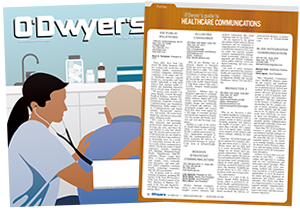 James Heins James Heins |
However, in a larger sense, integrated communications can be described as a communications management process that focuses on conveying messages in a clear and consistent manner that reaches and resonates with a variety of audiences. This means “integrating” the perspectives of all stakeholders and disciplines into a core set of messages that are faithfully delivered through all campaigns and communications channels.
|
|
Life sciences and medical technology companies in particular should recognize and take advantage of the fact that, due to the proliferation of digital communications channels, their messages about innovation and value are being delivered to, and digested by, more than one set of stakeholders. Still, many healthcare companies are only thinking about one target audience at a time (e.g., investors or prescribers) or have different parts of their organization speaking disparate, incongruent messages to the same audiences.
For example, a public company may want to communicate the results of a clinical trial to meet SEC disclosure requirements and attract more investors. However, scientific thought leaders and patient advocacy groups who have a stake in the eventual introduction of the investigational therapy may also find value in the information. If the company hosts an analyst conference call to talk about the new data, it’s important that the message is comprehensible to and resonates with multiple stakeholders, engenders understanding and support, mitigates the potential for misunderstanding and opposition, and stays within the boundaries of regulatory guidelines.
If a reporter for a widely-read publication listens in on the call and reports about the study, for instance, it can help healthcare professionals and patients understand the company’s R&D progress. But if the story quotes a company executive telling call participants that the results demonstrate the safety and efficacy of the therapy, it may be viewed by the FDA as an unsubstantiated claim for an unapproved therapy. There is a fine line between objectively reporting data and making promotional claims that are not sanctioned by the FDA, particularly when anyone may be reading or listening to your communications.
One of the biggest challenges to achieving communications integration in the agency and corporate setting is culture. The larger and more established your organization, the more critical integration becomes and the more difficult it can be to achieve. A marketing manager who’s focused solely on communicating about a product or a functional head who can’t be bothered to try something new can both be impediments to your efforts. Of course, the world won’t come to an end if a marketing campaign doesn’t include corporate branding messages or doesn’t speak to all potential audiences, but a series of missed opportunities can ultimately impact the organization’s ability to effectively communicate its overall value.
Even though this all makes sense and indeed may seem obvious, in my experience, integrated communications does not happen more often than it does. So what do you do when an organization resists integrating the communications process?
Be Persistent. It’s worthwhile, but if it were easy, everyone would be doing it already.
Build Relationships. If your colleagues and clients are all on board and rowing in the same direction, count your blessings. Otherwise be prepared to work at it. Organizational inertia and busy colleagues are just as big a barrier as limited resources and budget. Demonstrate to your peers that what you are proposing will help them and that by collaborating, their efforts will have an impact not only on the entire organization but their area of responsibility as well.
Start Small. You don’t have to do it all at once. If you don’t have the resources and budget to use all available channels and touch every audience, choose one or two channels and a small universe of stakeholders and build from there.
Demonstrate Value and Impact. I worked with a cross-functional team of colleagues to implement a corporate communications campaign to raise the visibility of the organization’s value-added and CSR programs. Our marketed products were never mentioned. We used the results and KPIs from past commercial marketing campaigns as a benchmark to measure performance and knocked it out of the park, exceeding the goals across all channels by a wide margin. We also showed that the perception among key stakeholders of the value the company was providing increased year over year. The icing on the cake was when the marketing team member on the project extolled the value of the program to his supervisors and peers, and they got on the integrated communications bandwagon.
Repeat. One and done doesn’t work. Lack of commitment or budget can shorten the lifespan of many a good program. That’s why having data and metrics that demonstrate that you are moving the needle in the right direction is critical.
In summary, integrated communications can help your organization reach target audiences more effectively than traditional news channels like press releases and media alone. But it’s more than just using multiple channels. It is a communications management process whereby different functions within an organization work collaboratively to communicate clear, coherent, consistent and complimentary messages that maintain and enhance the overall value and visibility of an organization among an array of stakeholders. When it happens, it’s beautiful to behold.
* * *
James Heins is Senior Vice President and head of healthcare PR at ICR.



 Lo Isidro, senior director at Real Chemistry with more than a decade of strategic communications and PA experience, has joined Narrative Strategies.
Lo Isidro, senior director at Real Chemistry with more than a decade of strategic communications and PA experience, has joined Narrative Strategies. Nelson Fernandez, former North American chair of APCO Worldwide and managing director of Burson-Marsteller, has joined Volunteers in Medicine Berkshires as director of communications and PA.
Nelson Fernandez, former North American chair of APCO Worldwide and managing director of Burson-Marsteller, has joined Volunteers in Medicine Berkshires as director of communications and PA. Lilit Bargar, who was most recently an EVP in the healthcare practice at Weber Shandwick, comes on board at GCI Health as EVP, corporate practice lead.
Lilit Bargar, who was most recently an EVP in the healthcare practice at Weber Shandwick, comes on board at GCI Health as EVP, corporate practice lead.
 Five ways that successful thought leaders are made.
Five ways that successful thought leaders are made.


 Have a comment? Send it to
Have a comment? Send it to 
No comments have been submitted for this story yet.